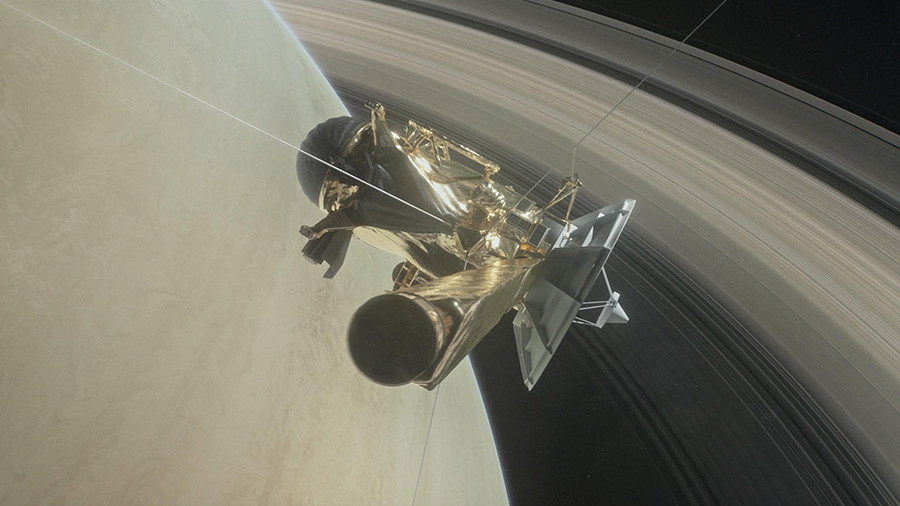Cassini probe began to descend into the atmosphere of Saturn, from where it will not return

Photo: Global Look Press / JPL-Caltech
On Geektimes , they repeatedly wrote about the Cassini probe, which for several years has been helping scientists explore the solar system and the objects in it. For a decade, the probe collected data on the planets of the Solar System from their satellites. With it, in particular, it was possible to detect the whole ocean of water on Enceladus , and also to learn about the existence of seas of methane on Titan.
The probe was most actively investigated by Saturn, in orbit of which it has been located since 2004, and its satellites. In particular, last year he moved from the pole to the pole of the gas giant. Each such passage went through the outer region of the main rings of the planet. The scientific instruments with which the apparatus was equipped made it possible to collect and analyze particles of matter and gases from various regions of Saturn's rings. Unfortunately, Cassini will soon stop working, ending his life in the atmosphere of Saturn.
On August 14, the system made one of the first dives into the upper layers of the gas giant. This can be said to be the beginning of the end, the scientists planned to complete the mission of the device. This stage is called " Grand Finale ."
Having made five successive dives into the atmosphere of Saturn, with an exit to the top, the probe will begin the sixth descent, after which the ascent will not follow. Cassini will descend lower and lower until it is destroyed by monstrous pressure and other conditions incompatible with the life of the apparatus that prevail on the giant planet. But the destruction of the device will not be in vain - it should give scientists a lot. In particular, it will be possible to obtain a lot of information about the characteristics of the upper and middle layers of the atmosphere of Saturn (the apparatus will not reach the lower ones in working condition).
The last immersion in the dense atmosphere of Saturn will begin on September 15th. Unfortunately, the device will not be able to transmit data for a long time - the device’s engines will already be useless, and Cassini will not be able to hold the antenna in such a way that the data is directed exactly to the Earth.
In the final, it will be very close to the upper clouds - at a distance of between 1600 and 1700 km. Scientists do not yet know what the conditions are near the planet. At this stage (before the final immersion) Cassini will still be able to correct his position in space with the help of engines. Whatever it was, but the device will collect a lot of data. In particular, Saturn’s “Northern Lights” will be studied, information about temperature on the planet will be obtained, and scientists also hope to better understand the nature of the hexagonal hurricane.
Radar devices will be able to catch the structural elements of the atmosphere with a size of 25 km. This is 100 times less than it was possible from the usual orbit, on which the device was located until now.
The Grand Final also provides for a passage near Saturn’s largest satellite, Titan. It will happen on September 11th. Titan's gravity will slow Cassini's speed and change its trajectory in such a way that the probe will fall into the upper atmosphere of Saturn on September 15th.
“During these five days, which will be the last for Cassini, it will become the first Saturnian atmospheric probe in history,” said project representative Linda Spilker, a NASA employee. "We have long planned to send a probe into the atmosphere of Saturn, and we plan to study the data in order to continue research in the future."
Scientists decided to send a probe to perform a deadly task for him for a reason. The fact is that in the course of many years of service to the Earth, Cassini spent almost all of its fuel. For the project team, this did not come as a surprise, and she developed a script ahead of time that would help the probe to obtain valuable information for science before it disappears behind the clouds, in the direct and figurative sense.
About what "sees" Cassini, being near Saturn, will help to get an idea of the video collected from thousands of photos. Video quality - 4K.
By the way, thanks to this very zone, the specialists got an idea of the structure of Enceladus. It turned out that the planetoid, covered with a crust of ice, hides under it an ocean of warm water. Preliminary research findings suggest that the subglacial environment is suitable for the existence of life there. But to say for sure, unfortunately, it is impossible, since further research is needed. Thanks to Cassini, it became clear that liquid water in the solar system is the rule rather than the exception. This means that the probability of the existence of life outside the Earth also increases.
All Articles